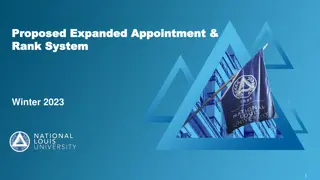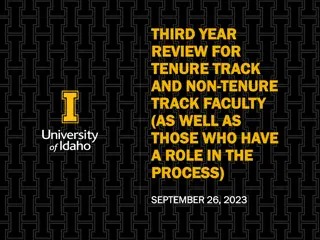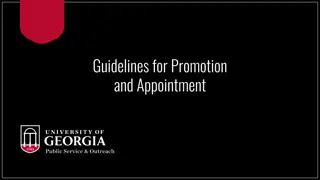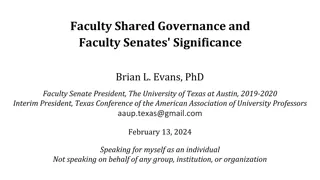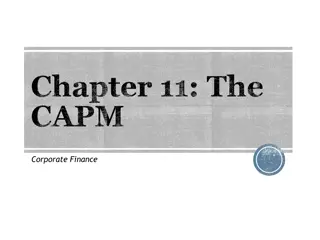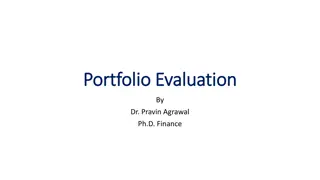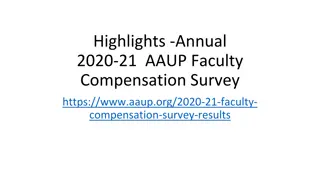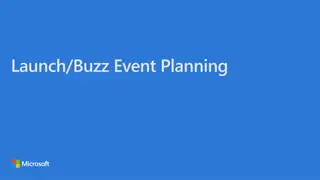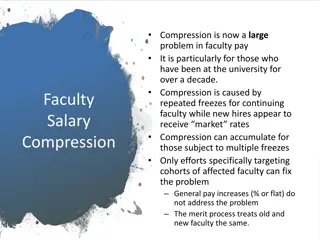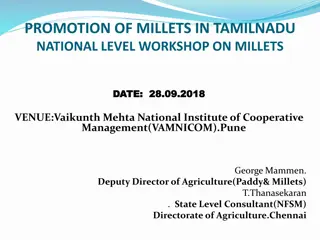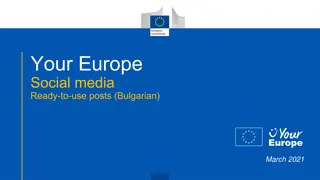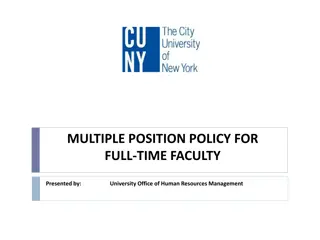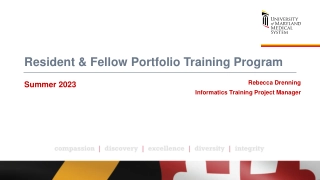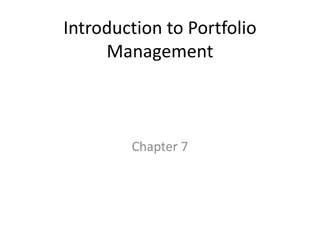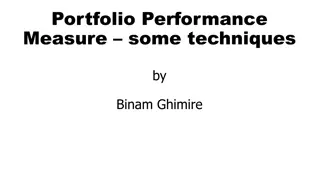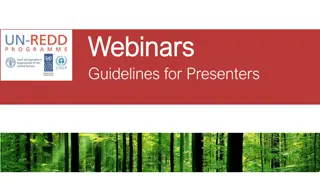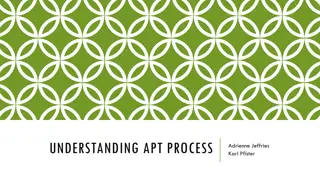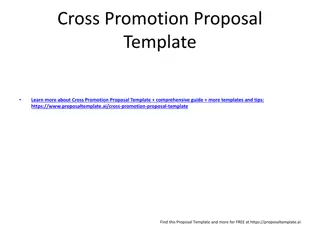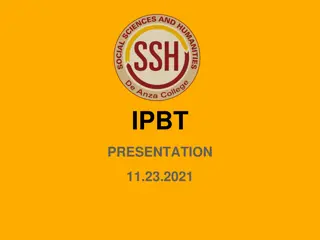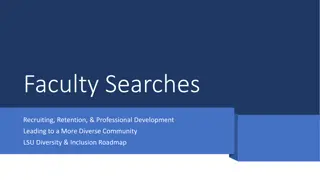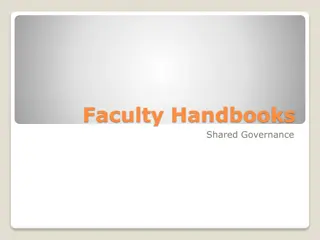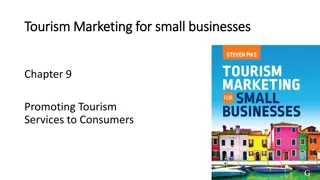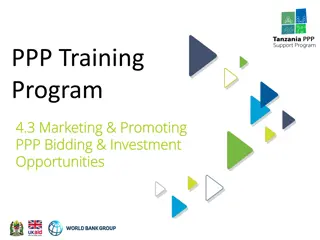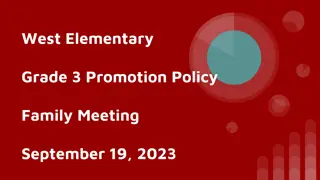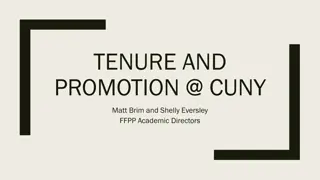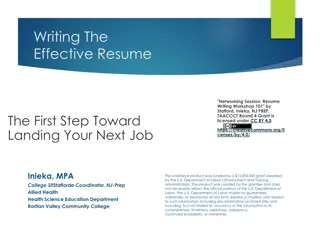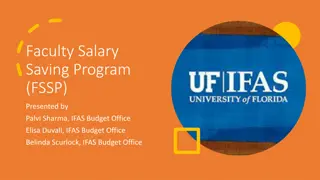Guidelines for Creating a Comprehensive Portfolio Workshop for Faculty Promotion
Develop a structured portfolio for faculty promotion with clear guidelines on content organization, timing for promotion eligibility, and application processes. Utilize detailed sections like cover page, table of contents, letter of application, teaching activities documentation, and more to support faculty progression. Ensure compliance with tenure requirements and provide support for extensions in exceptional circumstances.
Uploaded on Sep 13, 2024 | 0 Views
Download Presentation

Please find below an Image/Link to download the presentation.
The content on the website is provided AS IS for your information and personal use only. It may not be sold, licensed, or shared on other websites without obtaining consent from the author. Download presentation by click this link. If you encounter any issues during the download, it is possible that the publisher has removed the file from their server.
E N D
Presentation Transcript
PORTFOLIO WORKSHOP 2024-2025
TIMING Faculty are eligible for promotion after 4 years in current rank. Application happens at 3.5 years. New TTF must apply for and receive tenure at the 4-year mark to continue employment. (Extensions are only available for extenuating circumstances but must be applied for before October 1.) After the first promotion and/or tenure, faculty may take longer than 4 years if they choose.
PORTFOLIO CONTENTS
SECTION ONE A. Cover Page B. Table of Contents C. Letter of Application D. Opening Remarks E. Letters of Recommendation F. Annual Faculty Performance Appraisals G. Faculty Observation Reports
SECTION TWO A. Teaching and Learning Activities (Instruction, Assessment, Advising) Teaching Philosophy and Narrative Documentation B. Professional Activities (Development, Scholarship, Service to Profession) Narrative Documentation C. Service Activities (Department, Division, College, Community) Narrative Documentation
COVER PAGE The cover/opening page of the portfolio must include the following information: Name Current Rank Rank Applying For Department Division Submission Date
TABLE OF CONTENTS This should be a detailed listing with not only section titles but also the candidate s identified subheadings within the categories and included documentation. (Sample in Appendix I of the Handbook)
TABLE OF CONTENTS Because it can be difficult to format outlines in Blackboard, you may choose to insert a frame with the document or post a JPEG or PNG picture of the pages as well as attaching a PDF copy for reviewers to print if they desire.
LETTER OF APPLICATION A copy of the letter that was submitted to the department chairperson, the division dean, and the SVPAA by October 1. Includes the faculty member s name, current rank, and rank being applied for (and tenure, if applicable). Sample letter is found in the appendix of the handbook.
OPENING REMARKS The opening remarks are meant to set the stage for the portfolio, to provide a context. The remarks might include your professional history an explanation of your department and work requirements a quotation or reference to a book anything else significant to you The tone may be formal or informal, as the candidate chooses. Generally, opening remarks fall between 300 and 750 words.
LETTERS OF RECOMMENDATION Committees and administrators will produce recommendation letters as the portfolio moves through the process. In the digital shell, there is a placeholder in Section One where the facilitator will add the letters.
ANNUAL APPRAISALS Include all appraisals since last promotion Minimum of three Reverse chronological order
OBSERVATION REPORTS Refer to Handbook for numbers required Reverse chronological order If any are missing, include your own explanation (with documentation), or an explanation from the chairperson and/or PRT.
SECTION NARRATIVES Start with a general intro to the section stress growth and continuity. Use your draft Table of Contents to guide your writing. Use the subdivisions within the categories to structure your narrative. Explain how and why included activities support exemplary performance. Every activity mentioned must be supported by documentation; every piece of documentation should be alluded to in the narrative.
TEACHING PHILOSOPHY An articulation of the fundamental principles that guide a faculty member s teaching, assessment, and advising strategies and overall approach to the discipline The overarching objectives Cognitive, behavioral, and affective goals Info, skills, ethical considerations Support generalizations with concrete examples Explain course design related to goals Discuss assessment methods that ensure achievement of objectives Identify teaching behaviors that support goals
DOCUMENTATION Professional Development Reports, Committee Contribution Reports, emails, agendas, handouts, syllabi, thank-you notes, flyers, programs, minutes, reports, screen shots, letters, membership cards, certificates, transcripts, assessments, worksheets, lesson plans, scripts, lists, title pages, photographs, newspaper articles, etc.
GENERAL DOCUMENTATION TIPS Avoid using multiple pages to document each activity when one will suffice. Choose documents that reflect actual contributions rather than planned or future participation. Provide only a page or two of lengthy documents, brief video clips rather than entire videos, and a few slides rather than full PowerPoint presentations. Provide representative examples of instructional units and other materials instead of multiple examples. For assessments, provide rubrics, keys, or graded assignments showing the type of feedback given.
GENERAL DOCUMENTATION TIPS Never use the same piece of documentation twice in the portfolio. Avoid including publisher materials or anything substantially created by another party. If the inclusion of such material is necessary, the source must be clearly cited and the reason for including such material clearly explained. Redact names on some documents to protect privacy (e.g., student assignments or recommendations, faculty observations). Ensure that all links in the digital portfolio are active and all documents are accessible on a wide variety of devices.
TOP DOCUMENTATION TIPBE A MINIMALIST! Do not add multiple items to document one activity choose the most effective proof.
PREPARING THE PORTFOLIO
1. REVIEW THE CURRENT P&T HANDBOOK AND VIEW RECENT EXEMPLARY PORTFOLIOS.
2. DECIDE WHAT WILL BE INCLUDED IN EACH SECTION. Review appraisals, calendars, emails, etc.
3. PUT TOGETHER A DRAFT TABLE OF CONTENTS. Share it with PRT for feedback.
4. GATHER REQUIRED DOCUMENTS. Appraisals Observation Reports Make sure they have all required signatures. Chairs and Deans should have copies if you need them.
5. FIND DOCUMENTATION FOR EACH ACTIVITY IN THE OTHER SECTIONS. Place items into virtual folders on your computer or OneDrive. Rename items in a meaningful way and save as PDFs.
6. WRITE NARRATIVES. As you finish each one, share it with PRT for feedback. Avoid adding special formatting until you copy it to Blackboard.
7. ONCE YOUR NARRATIVES ARE WRITTEN, REVISED, AND EDITED, AND ONCE YOUR DOCUMENTATION IS ORGANIZED AND APPROPRIATELY NAMED, MOVE TO FORMATTING IN BLACKBOARD.
REQUEST A PORTFOLIO ORG TEMPLATE Send an email to DEIS (teaching@cscc.edu) to request the following: 1. A new ORGANIZATION for a promotion portfolio. 2. With the FAC-PORTFOLIO-ORG (Faculty Portfolio Shell) copied to it. 3. Request the title of the ORG to be your name and the rank you are seeking: Jane Doe Promotion Portfolio for Assistant Professor 4. Request that the ORG identifier reflect your username and whether this is your first, second, or third digital P&T portfolio (to assure that previous portfolios are not overwritten): a. FAC-PORTFOLIO-ORG-JDOE-1 (if first digital portfolio) b. FAC-PORTFOLIO-ORG-JDOE-2 (if second digital portfolio) c. FAC-PORTFOLIO-ORG-JDOE-3 (if third digital portfolio) 5. Request LEADER ENROLL status for yourself. With this status, you will be able to add names of pre-submission reviewers (including your Peer Review Team) as PARTICIPANTS. In November, you will have the names of the facilitators added with LEADER ENROLL status.
SAMPLE EMAIL TO DEIS: Hello, Please create a new ORGANIZATION for my promotion portfolio. 1. Copy the FAC-PORTFOLIO-ORG (Faculty Portfolio Shell) to it. 2. Title it Jane Doe Promotion Portfolio for Assistant Professor 3. Make the ORG identifier FAC-PORTFOLIO-ORG-JDOE-2 4. Give me LEADER ENROLL status. Thank you for your assistance! Jane
After submission of the portfolio on the first Friday of spring semester, the two facilitators will handle all the additions and deletions of committee and administrative readers and the uploading of recommendation letters. The candidate will be removed once the portfolio has been submitted (and re-added briefly if repairs are required). After the process is complete, the candidate will be added back as a leader enroll and the facilitators will be removed.
Necessary Skills for Digital Portfolios: Scanning Documents Creating PDFs Adding Items and Files to Blackboard Renaming files Creating links to files Adding videos
DEIS is ready to assist you with all Blackboard-specific questions. The P&T Fellows and Process Committee members will help with all other questions.
GENERAL TIP: START EARLY! Set a goal date of November 15th to have everything done except final reviews and edits.
RESOURCES Leslie Smith, Faculty Fellow Dan Hare, Faculty Fellow Heather Johnston, Co-Chair, P&T Process Committee Jeremy Banta, Co-Chair, P&T Process Committee DEIS 3dman_eu Pixabay


